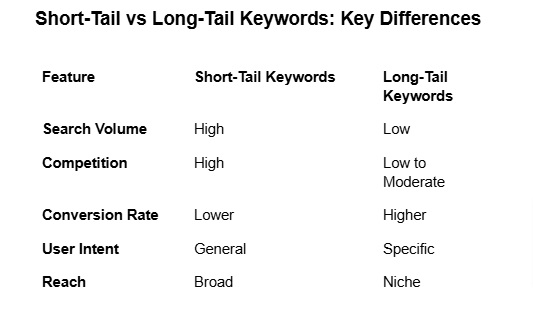Keywords are the core of any digital marketing campaign to connect relevant content with audience intent. That makes them highly important, yet as you look to squeeze every last drop out of your online presence and channel enough traffic to your website, should you be targeting short-tail keywords or long-tail keywords? Understanding the differences as well as how each form of keyword affects your SEO strategy will help you make more effective content and improve your site’s visibility. This post is a delve into the complexities of both types, when to use each, and how a balanced approach can help you hone your optimization. Let’s read the article about long tail vs short tail keywords below.
What Are Short-Tail Keywords?
Short-tail keywords are often called “head keywords.” They typically include one to two words, are broad, high-volume terms, and can take in a whole wide audience very often, such as “shoes,” “digital marketing,” or “technology.”
Characteristics of Short-Tail Keywords:
# Huge search volume: Short-tail keywords attract thousands, even millions, of monthly searches.
# High competition: For popular short-tail keywords, competition is tough due to their general nature.
# Vagueness in intent: Users searching those terms may not have any specific intent, making it difficult to measure user requirements.
Benefits
Masses reach: Short-tail keywords attract a lot of traffic; hence these words are perfect for brand awareness campaigns.
High Search Volume Potential: More searches imply better chances of garnering more visitors to your website.
Presence for Brand: Ranking in high traffic short-tail terms is good enough for that brand to be the best source for the specific category.
Challenges
# Lower Conversion Rate: Since short-tail keywords attract a large audience, the conversion rate is not that great.
# Costly: With all unpaid campaigns, paid rankings for short-tail keywords are costly and often quite competitive due to large search volumes.
For instance, a website selling shoes might rank for the term “shoes”, but it is not going to attract a buyer looking for “comfortable running shoes”.
What Are Long-Tail Keywords?
Long-tail keywords would be keyword phrases, typically containing more than two words and three or more in most cases. They are often more specific terms than either single or two-word terms. These keywords are more specific, holding intent that is well-defined: “best lightweight running shoes for women.”
Characteristics of Long-Tail Keywords:
# Lower search volume: Long-tail keywords naturally tend to have fewer searches, but targeted.
# High conversion rates: These keywords target audiences with specific needs, most often arriving at a higher conversion rate.
# Less Competitive: Because of specificity, long-tail keywords tend to be less competitive and therefore rank easier.
Benefits
# More Conversion Rate: As long as those searching for a particular thing will ultimately find it, more possibilities exist for conversion.
# Low Paid Search: For PPC or paid search, use of long-tail keywords generally will save money.
# Ideal Targeting: When there is a particular target with regard to the niche business, then this is the perfect approach in terms of keyword optimization.
Challenges
# Low Volume: Low volume searches result in fewer visitors and could also be detrimental to your high-volume targets.
# Research-Based: It takes more research into the intent of the user to identify relevant long-tail terms.
# Case Study: Optimizing a blog post for “best running shoes for flat feet”. The audience reached will be highly interested in such a shoe type, and there will be higher chances of conversion.
Short-Tail vs Long-Tail Keywords: Key Differences

Short-tail keywords attract a broad audience but face high competition and often lower conversions. Long-tail keywords, however, target specific queries with less competition and higher conversion potential.
When to Use Short-Tail Keywords
Best Used for:
# Brand Awareness: Simply, short-tail keywords are the best at making some brand known among a mass audience.
# At the Top of the Funnel: If you need to target people in the early awareness stage, then short-tail keywords can be used-for general information regarding products or services.
Industries Suitable for Short-Tail Keywords:
# E-commerce: Brands trying to reach a wide target market for general products, such as clothing and electronics.
# News and Media: For high-traffic articles or news pieces covering broad topics.
Example: A cosmetics brand may target “skincare” for broad exposure, though the competition might be quite high.
When to Use Long-Tail Keywords
Best Uses:
# Targeted Campaigns: Long-tail keywords are great for grabbing users further down in, or at the bottom of, the sales funnel who have very targeted buying intent.
# Niche Markets: Small businesses or niche products profit much more with long-tail terms as they can reach higher numbers of relevant audiences.
Industries that are fit for long-tail key terms
# Local Services: Small businesses targeting local customer bases (for example affordable SEO services for small businesses).
# SaaS and software: Companies with niche solutions can capture interested prospects using long-tail terms.
For instance, this keyword would help Seattle’s best gluten-free bakery attract local clients catering to the specialized needs of these individuals.
How to Combine Short-Tail and Long-Tail Keywords
Keeping the balance between keyword strategies can bring up the maximum reach and conversion potential of your website. You may blend both types to create brand awareness using short-tail keywords while sending targeted traffic using long-tail keywords.
Tips on Mixing Both:
# Use Short-Tail Keywords for Landing Pages: These attract broader audiences who might later go to more specific pages.
# Optimize blogs and product pages for long-tail keywords: Long-tail keywords can bring visitors further down the funnel, thereby improving conversions.
For instance, a tech blog may optimize its homepage for “technology trends,” but use long-tail keywords in different articles like “top AI trends in cybersecurity.”
Keyword Research Best Practices
Keyword Tools:
# Google Keyword Planner: Great for initial keyword ideas and search volume insights.
# Ahrefs and SEMrush: Both of these are great keyword research tools for analyzing competition, getting long-tail keyword suggestions, and keyword difficulty.
Golden Rules for Good Keyword Research
# Identify Competitor Keywords: Locate popular keywords that their competitors use.
# Utilize Google’s Autocomplete and “People Also Ask”: These can give long-tail keyword ideas that are truly valid user queries
# Ensure Relevance: Use keywords that will better serve your target audience’s needs and intent
Conclusion
Long tail and short tail keywords are equally important in a well-rounded SEO strategy. Short-tail keywords help build brand awareness, while still allowing you to attract a humongous audience. Long-tail keywords will, on the other hand, increase conversions by targeting specific user intents. A good balance of both would enable you to reach broader audiences and drive effective conversions. Consider your business goals and assess your target audience to develop a keyword strategy that drives the most out of your website’s SEO potential.

